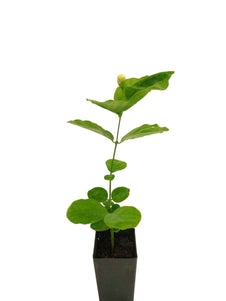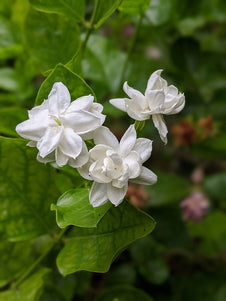









Jasmine Sambac
Jasmine Sambac
- In stock, ready to ship
- Inventory on the way

Usually available: November to April
Life cycle: Perennial
Height: 2 - 3m
Position: Sun / part shade
Soil preference: Well drained
This is how we pack and send your Herb Plants to all states except TAS & WA
You will receive
- 1 Jasmine Sambac Herb Plant in a 50 X 75mm tube - General growing instructions
All of our Herb Plants are grown organically with certified organic potting mixes and fertilizers
Botanical Name: Jasminum sambac
Jasmine sambac, "Grand Duke of Tuscany' is an extremely fragrant, evergreen climber or scrambling shrub which can grow up to 2 meters high and 2 meters wide in ideal tropical conditions. The leaves are ovate and a glossy, dark green and they may appear in whorls or in opposite pairs. The intensely fragrant, white, waxy flowers resemble miniature gardenias and appear in clusters, although each flower is only about 1 cm in size. The plant blooms in summer and may have flowers throughout the year in consistently warm climates.
J. sambac has been cultivated for many centuries as an ornamental plant and for its fragrant flowers, which have health and culinary benefits. Its native habitat is in South East Asia and the plant most likely originated in India, where it is one of the most popular ornamental plants grown. Jasmine sambac is ideally suited to tropical and temperate areas, but does well in most areas of Australia. It may be frost affected in some areas, but will generally bounce back.
The plant is widely grown for its beauty and fragrance with the flowers used in teas, perfumes and oils. The flower buds can be harvested in the early morning according to size and firmness. It is important to make sure they are white, rather than still green, because the oils responsible for the fragrance are not as well developed. Open buds have already started to lose their oil content and are less fragrant, so many more would be needed to extract the same volume of oil.
Growing Conditions
Jasminum sambac grows from 2-3 meters high and can spread a similar distance, depending on local conditions. There are several different cultivars, with the “Grand Duke of Tuscany’ being among the most popular. It spreads by sending out angular shoots that can be trimmed to create a shrub-like appearance. In areas subject to frost it may need to regroup and send up new shoots each year. If this is the case, the spread and height will be restricted and it will be a smaller plant. The white flowers will fade to a pinkish colour as they age.
As a tropical plant, jasmine sambac does prefer moist, fertile soils, but does not like to be water logged. The best aspect is full sun, but part shade produces good results and can offer some protection from drying out in the hot summers. Some people use multiple plants to produce rambling hedges in larger gardens. If possible, plant it where you can appreciate the fragrance as you go about your day. It does well in pots that are well watered and mulched, so growing a plant in your outdoor entertaining area might be an option.
Medicinal Uses
The flowers of jasmine sambac, like true jasmines, have antioxidant benefits as a result the many active constituents. There may also be an anti-inflammatory component. These same oil components are responsible for the lovely fragrance, which is used in many perfumes. The leaves are antiseptic and are useful for wounds or acne when used as a poultice. Both leaves and flowers can be used in a sauna or steam bath as a tonic for easing the mind and headaches.
If you would like a relaxing bath treatment you can make an infusion by taking one cup of flowers, one cup of oatmeal and ½ a cup of shaved soap flakes and soak them in a bowl of hot water. Then squash the ingredients together place in a cloth and tie it up. A man’s handkerchief is a good size. Use it to massage over your body and then let yourself relax and experience the mood lifting properties and the wonderful fragrance of the flowers.
Culinary Uses
Jasmine sambac flowers have been used to flavour tea for many centuries by the Chinese. Jasmine tea is most commonly consumed with or after meals as a digestive aid. Some people like to drink it after rich or fatty meals to help cleanse the blood. Others use it to cleanse freshen their breath after eating strong tasting foods, but it is a nice all round tea. The flowers are also edible and have a sweet taste.
If you’d like to try making a nice relaxing and rejuvenating tea fill ¼ of a cup with fresh leaves and flowers from your garden and add to one cup of boiling water. Let it stand for 5 minutes then strain off the plant materials. Drink warm or cold if you prefer.
All information provided on this website is for informational purposes only. Please seek professional advice before commencing any treatment.





